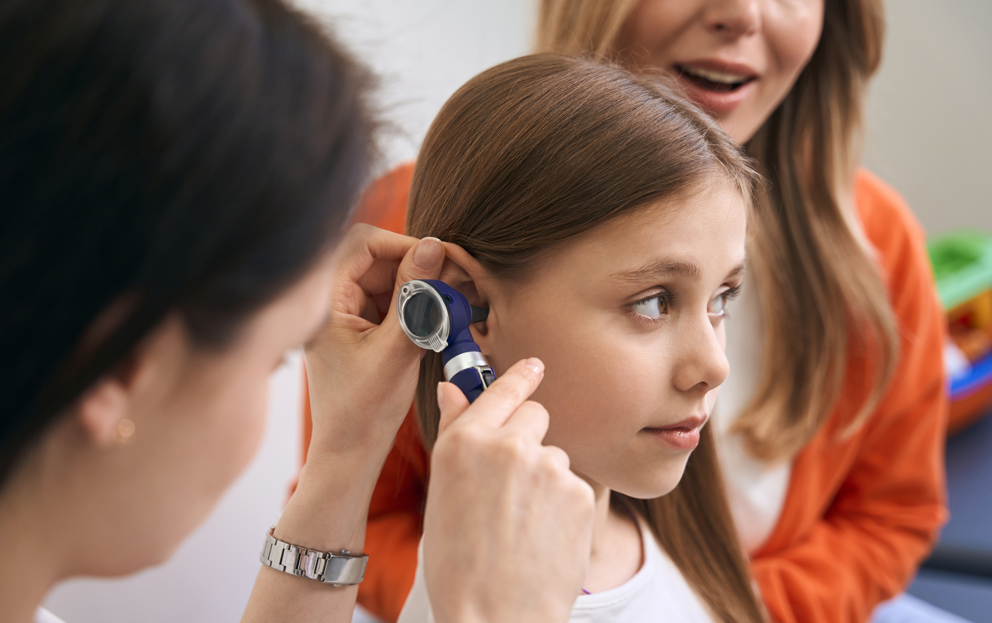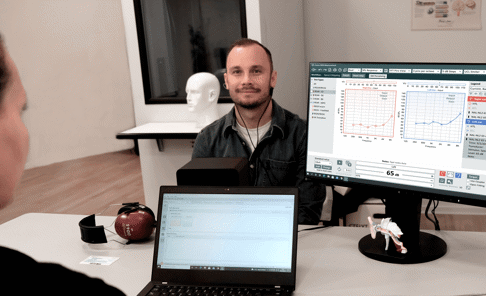
The Importance of Hearing Screenings in Schools
Untreated hearing loss in kids is frequently linked to learning difficulties and can negatively impact their language development. It’s often associated with academic underachievement, which can lead to reduced employment opportunities when they’re older. Children that can’t hear properly – or participate easily in conversations – may also have social troubles, withdrawing and isolating, which can be detrimental to their self-esteem, confidence, and overall happiness.
Hearing screenings in schools can be an effective way to identify potential hearing loss and refer these children to hearing care professionals for solutions and support to help them hear better. In fact, early identification and appropriate interventions allow children to receive appropriate tools, resources, and support, and can help them avoid the negative outcomes associated with untreated hearing loss.
Hearing screenings in schools are instrumental in identifying possible hearing impairments and getting these children more thorough testing and – if warranted – hearing aids or other solutions.
Targeted Age Groups for Screening

According to the Centers for Disease Control, 98.2% of babies born in the United States are screened for hearing loss shortly after birth. And while two out of every 1,000 babies in the U.S. are born deaf or hard of hearing, some children develop hearing loss later due to illness, injury, environmental causes, genetics, or other causes. The hearing loss may be temporary (due to things like excess earwax or an ear infection) or permanent, and can range from mild to severe. In fact, by the time they reach school age, nearly 15% of children in the U.S. have some type of hearing loss.
According to the American Academy of Pediatrics (AAP), hearing screenings should be conducted:
- When children start school.
- At ages 6, 8, and 10.
- At least once during middle school.
- At least once during high school.
More frequent hearing screening may be necessary for students with other health or learning issues, including speech, language, or developmental delays, and/or a family history of early hearing loss.
Screening Process Overview

When conducting hearing screenings on children in schools, it’s essential to use high-quality equipment such as portable diagnostic audiometers. The proper hearing screening equipment for schools will make testing and diagnosing hearing disorders easier for the professionals administering the tests.
Schools’ hearing screening programs should use professional guidelines, such as the AAP Criteria for Successful Screening Programs in Schools, to ensure that:
- Screening tests are accurate and reliable.
- The screening sites are quiet and suitable to conduct the screenings.
- People screening the students’ hearing are well-trained, qualified professionals.
- Referral mechanisms are set up so that any child who fails the screening test (or shows other signs of hearing loss) can be sent to a hearing care professional for additional testing, evaluation, diagnosis, and appropriate treatment, as needed.
- The school correctly and effectively shares screening results with each child’s parents or guardians and healthcare providers.
- Appropriate educational interventions are implemented to maximize each child’s successes in the classroom.
When assessing hearing in students, the following testing methods are considered best practice:
- Pure tone hearing screenings to identify whether a child is able to hear sounds across different frequencies.
- Ear examinations using otoscopy, as needed, to determine whether excess earwax, ear infection, or other issues could be contributing to the hearing loss.
How to Choose the Right Hearing Screening Equipment for Schools
Hearing care professionals should use equipment that can properly screen children’s hearing. Ideally, the equipment should be accurate, durable, easy to use, and portable enough to set up in different school settings. The ideal screening devices should be quick to implement, offering accurate results in just a few minutes.
Use screening equipment designed with state-of-the-art technology that provide accurate screening results.
Key Features to Look For

When choosing hearing screeners and testing euipment, look for options that offer:
Precision
Use equipment that’s calibrated to detect even the slightest variations in hearing ability to provide the most accurate assessments and diagnoses.
Efficiency
The best equipment streamlines the screening process, saving time and resources. Rely on models with a user-friendly interface and intuitive features to make screenings quick, accurate, seamless, and stress-free.
Reliability
Ideally, you’ll use reliable devices to ensure consistently excellent performance, with accurate results every time.
Customization
Hearing care professionals may need to customize screenings based on different requirements, such as screening at a school vs. in different settings, so look for equipment that offers customizable settings to better cater to the specific needs of the people you’re screening.
Portability
Lightweight, easy to carry equipment is essential for screenings at schools – or in other community locations – so look for a portable audiometer that’s simple to use (and bring) on-the-go.
The opportunity to provide Best Care Experiences
Prioritize student comfort with non-invasive equipment, ensuring a positive and stress-free experience for the students you’re screening.
Clear, accurate results
Efficiently manage and analyze screening data for better patient care and prompt referrals for further tests, diagnoses, and treatment, as needed.
Comparing Different Screening Methods

Choosing the right equipment for audiologists conducting hearing screenings in schools is crucial.
Traditional stand-alone audiometers:
Traditional audiometers offer comprehensive testing capabilities but vary in size and may not be ideal on-the-road equipment.
Modern, PC-based audiometers
PC-based audiometers are often more portable and represent a significant advancement in hearing screening technology, blending portability with the precision of traditional audiometers. These devices are specifically designed to meet the dynamic needs of audiologists conducting screenings in schools, providing a perfect balance between functionality and mobility.
Implementing School Hearing Screening Programs
Since most children attend school, schools are an ideal location to conduct hearing screenings. When the screenings indicate possible hearing difficulties, the children can be referred to audiologists for more comprehensive hearing tests, diagnoses, and appropriate interventions.
Hearing clinics play a pivotal role in promoting the importance of hearing health, and partnering with schools presents a prime opportunity to instill this awareness from an early age. By engaging with students on the significance of proper ear care, safe listening habits, and the use of hearing protection, hearing clinics can lead the charge in preventive education.
Building Community Partnerships

Hearing clinics should build partnerships with the schools in their communities, offering to provide hearing screenings and help promote hearing health. As part of this effort, your hearing clinic should:
- Contact local schools (elementary, junior high, and high school) to offer your screening services.
- Spotlight your experienced clinicians and best-in-class screening equipment.
- Explain that when children fail their hearing screening – signaling possible hearing loss – they can be seamlessly referred to your clinic for further testing, diagnosis, and treatment (as needed).
- Highlight the seamless process of having your staff screen the children and follow up with those with hearing problems.
- Offer resources to support children with hearing loss.
- Provide information about hearing health, including safe listening practices and when to use proper hearing protection. Offer to speak to students and staff about hearing health topics.
Through collaborative partnerships with schools in their communities, hearing clinics can provide screenings and flag any children that might need follow up care from one of your audiologists. This is a good way to drive additional traffic to your clinic and increase Key Performance Indicators (KPIs) like sales, conversions, and customer satisfaction.
Staff Training and Support

Hearing clinics should train their staff to be able to perform hearing screenings in school. Clinics should also provide their staff with the best equipment for this endeavor.
Auditdata’s comprehensive solutions provide everything necessary to perform proper and complete hearing screenings in schools, including:
Clinical Workflows
Clinical workflows focus on how your hearing care providers conduct exams, improving quality, consistency, compliance, and patient outcomes. These clinical workflows outline the timing and sequence for clinical examinations and procedures. This approach helps standardize care, guide clinicians’ decision-making, and ensure that all clinicians follow the same path to provide the most appropriate care, including knowing when to refer children for further testing, diagnosis, and treatment. The significant benefits of using clinical workflows include improving patient outcomes, the quality and consistency of healthcare, and resource optimization.
Notification Alerts
Highlighted audiometric nudging guides hearing care providers during examinations, through notification alerts ensuring they follow best practice testing protocols and don’t forget any steps in the process. This helps boost clinical quality in every hearing screening and exam.
Proper Onboarding
Properly trained staff can work more efficiently and consistently provide Best Care Experiences for patients. Using Clinical Workflows and notitication alerts allows hearing clinics to easily implement new protocols and onboard new staff by guiding the users through each step of the testing flow. This makes the onboarding of new staff faster and more seamless.
Supporting Students with Hearing Loss
Hearing care professionals can educate schools (and parents), suggesting different support methods for those with hearing loss.

Hearing care providers can also offer advice and insights to schools and teachers on how to best support hearing impaired students. Consider providing resources and solutions for schools (and teachers) that will benefit their students with hearing loss – and post these resources on your website for easy access. Tips could include:
- Create an IEP. It can be helpful for the school, working collaboratively with the child’s parents or guardians, to create an individualized education program (IEP) or 504 plan to help children with hearing loss reach their full potential. Plans may include a classroom aide or paraprofessional to assist with communication.
- Make seating changes. Children with hearing loss may need to sit closer to the front of the class to hear more clearly and/or to read the teacher’s lips. Consider arranging chairs in a U-shape or circle so that students with hearing loss can better interact with their classmates.
- Minimize background noise when possible. This may mean finding quiet areas for a student to work. Try to eliminate background noises – like music playing during lessons – so the child with hearing loss can hear their teacher and classmates better.
- Use an FM system. This device helps a child with hearing loss hear their teachers better in a noisy classroom. To use the system, a teacher wears a microphone/transmitter and the student wears the receiver, which amplifies sounds.
- Face students when you speak. Many students with hearing loss can read lips, so face them when you talk.
- Use pictures, graphics, and text labels. Many students with hearing loss are visual learners, so using graphics and pictures can be very helpful for them.
- Leverage technology. Put real-time captioning on any videos used in the classroom, and use voice-recognition software on computers. For more ideas, ask the student’s family, their audiologist, or ENT.
- Have a plan for missed school. Students with hearing loss may miss class time to go to doctor visits. Help the student make up any assignments and catch up on any lessons they missed.
- Talk about and celebrate differences. Students with hearing loss want to be accepted and treated like everyone else, but they may be targeted by other classmates for being “different.” Talk about – and celebrate – differences in an age-appropriate way. Be aware of any bullying and have a zero-tolerance bullying policy.
- Encourage participation. Encourage and empower all students to participate in classroom activities, physical education, and extracurricular activities. Ensure that all children are making friends and socializing appropriately.
Other Blogs You Might Enjoy:

What Do Your Hearing Aid Users Need?
If someone suspects they have hearing loss, they should see an audiologist for a hearing screening to determine whether they need hearing aids. But then what happens? This blog explains how to give your patients what they need for success with their hearing aids, such as setting proper expectations, providing care and maintenance tips for the devices, offering valuable tips before they buy, and providing ongoing aftercare.

Are Real Ear Measurements Necessary?
Real Ear Measurements (REM) – also called Probe Microphone Measurements (PMM) – are considered the gold standard in hearing aid fitting and verification, allowing audiologists to determine whether a hearing aid user is receiving the precise level of amplification needed at every frequency to maximize their hearing. This blog explains how REM can improve customers’ hearing, as well as drive better business outcomes and serve as a key differentiator for hearing clinics.

Common Audiometry and Hearing Loss Myths
Hearing loss is a prevalent condition that can significantly impact an individual's quality of life, yet misconceptions surrounding audiometry tests and hearing loss persist. This article aims to debunk common myths, providing clarity on the audiometric process and the nature of hearing impairment. By dispelling these misconceptions, we can foster a more informed and understanding approach to hearing health.
Don't Miss Out On the Latest Insights On Audiology
Sign up today to receive exciting updates, tips, and the latest newsletters from Auditdata.
Resources:
⭐️ Auditdata Measure - Diagnostic Audiometer & Fitting Unit
⭐️ Elevate Clinical Excellence with Advanced Configuration and Distribution
⭐️ Otoscopy- Auditdata Measure
⭐️ Real-Time Audiometric Quality Assessment And Notifications
⭐️ Loud Music Contributes to Hearing Loss, Impacting 1 Billion Young People
⭐️ Loud Noise Can Permanently Damage Your Hearing: The Importance of Hearing Protection
⭐️ Promoting Hearing Health in Schools
⭐️ Childhood Hearing Screening
⭐️ Hearing Screening Fact Sheet
⭐️ 2020 Summary of National CDC EHDI Data
⭐️ HEARING SCREENING CONSIDERATIONS FOR IMPLEMENTATION
⭐️ 12Clinical pathways as a quality strategy
⭐️ Clinical Pathways: A Critical Component of Success in Episodes of Care





